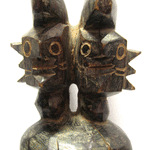Mumuye Bicephalous Figure, 1850 CE - 1910 CE
Wood
LSO.250
Further images
This powerfully-carved figure represents bicephalous conjoined (“Siamese”) twins, and was made by a master-carver of the Mumuye tribe. The construction of the piece is absolutely characteristic, with ribbon-like arms wrapping...
This powerfully-carved figure represents bicephalous conjoined (“Siamese”) twins, and was made by a master-carver of the Mumuye tribe. The construction of the piece is absolutely characteristic, with ribbon-like arms wrapping around a columnar body, set on strong, stocky legs, all carved with angular intensity that is accentuated by graceful curves and sinuous outlines that lend movement and vibrancy to the piece. The dynamic construction is especially clearly visible in profile, in which the sternly-angled legs and arms imply a muscular readiness, contrasting oddly with the high, crested double-head with its large ears and incised features. The piece is carved from a medium-colour wood that has become polished and darkened through handling and age. The surface is unadorned except for a band of angular geometric scarifications on the thorax, and a double scar on each of the faces’ four cheeks.
The Mumuye of Nigeria are comparatively understudied. They live in small villages, are primarily reliant upon farming, and are governed by the seven-grade Vabong secret society that holds flagellation-based initiation ceremonies for induction purposes. The artefacts associated with the Vabong are primarily masks, whereas Iagalagana figures – such as the current piece – are more closely allied with the family unit, under the guardianship of an elder. Iagalagana are carved by the village blacksmith or weaver. The pieces have apotropaic, divination and rainmaking powers, and served as house guardians while denoting the elevated status of their owners. They invariably possess deliberately distorted proportions, unanatomical limbs and a head that resembles a helmet or visor, usually with ornate, crested hair. They usually have exaggerated ears/lobes, pierced nasal septums for receiving stalks of maize (the current example has pierced nostrils) and highly simplified or nugatory facial features.
Twins are magical in the eyes of most African tribes, and while opinions of twins may be positive or negative, they regularly appear in artistic offrenda. Just as African groups (and the Yoruba in particular) have the world’s highest rate of twinning, so an accordingly increased prevalence of conjoined twins is inevitable. Some cultures have chosen to immortalise them, including the Lobi (see Barakat Gallery item number PF.5477) and the Yoruba; however, such representations are not common, and there are no known comparatives for the Mumuye. Bicephalous twins, incidentally, are among the rarest forms of conjoined twins known.
This rare and fascinating piece of African art would enhance any collection of which it was a part.
The Mumuye of Nigeria are comparatively understudied. They live in small villages, are primarily reliant upon farming, and are governed by the seven-grade Vabong secret society that holds flagellation-based initiation ceremonies for induction purposes. The artefacts associated with the Vabong are primarily masks, whereas Iagalagana figures – such as the current piece – are more closely allied with the family unit, under the guardianship of an elder. Iagalagana are carved by the village blacksmith or weaver. The pieces have apotropaic, divination and rainmaking powers, and served as house guardians while denoting the elevated status of their owners. They invariably possess deliberately distorted proportions, unanatomical limbs and a head that resembles a helmet or visor, usually with ornate, crested hair. They usually have exaggerated ears/lobes, pierced nasal septums for receiving stalks of maize (the current example has pierced nostrils) and highly simplified or nugatory facial features.
Twins are magical in the eyes of most African tribes, and while opinions of twins may be positive or negative, they regularly appear in artistic offrenda. Just as African groups (and the Yoruba in particular) have the world’s highest rate of twinning, so an accordingly increased prevalence of conjoined twins is inevitable. Some cultures have chosen to immortalise them, including the Lobi (see Barakat Gallery item number PF.5477) and the Yoruba; however, such representations are not common, and there are no known comparatives for the Mumuye. Bicephalous twins, incidentally, are among the rarest forms of conjoined twins known.
This rare and fascinating piece of African art would enhance any collection of which it was a part.





